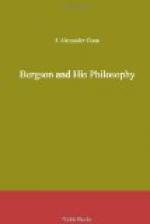In order to bring out the distinctly qualitative character of such a conception of Time, Bergson says, “When we hear a series of blows of a hammer, the sounds form an indivisible melody in so far as they are pure sensations, and here again give rise to a dynamic progress; but, knowing that the same objective cause is at work, we cut up this progress into phases which we then regard as identical; and this multiplicity of elements no longer being conceivable except by being set out in space— since they have now become identical—we are, necessarily, led to the idea of a homogeneous Time, the symbolical image of la duree.” [Footnote: Time and Free Will, p. 125 (Fr. pp. 94-95).] “Whilst I am writing these lines,” he continues, “the hour strikes on a neighbouring clock, but my inattentive ear does not perceive it until several strokes have made themselves heard. Hence, I have not counted them and yet I only have to turn my attention backwards, to count up the four strokes which have already sounded, and add them to those which I hear. If, then, I question myself carefully on what has just taken place, I perceive that the first four sounds had struck my ear and even affected my consciousness, but that the sensations produced by each one of them, instead of being set side by side, had melted into one another in such a way as to give the whole a peculiar quality, to make a kind of musical phrase out of it. In order, then, to estimate retrospectively, the number of strokes sounded, I tried to reconstruct this phrase in thought; my imagination made one stroke, then two, then three, and as long as it did not reach the exact number, four, my feeling, when consulted, was qualitatively different. It had thus ascertained, in its own way, the succession of four strokes, but quite otherwise than by a process of addition and without bringing in the image of a juxtaposition of distinct terms. In a word, the number of strokes was perceived as a quality and not as a quantity; it is thus that la duree is presented to immediate consciousness and it retains this form so long as it does not give place to a symbolical representation, derived from extensity.” [Footnote: Time and Free Will, pp. 127-8 (Fr. pp. 96-97).] In these words Bergson endeavours to drive home his contention that la duree is essentially qualitative. He is well aware of the results of “the breach between quality and quantity,” between true duration and pure extensity. He sees its implications in regard to vital problems of the self, of causality and of freedom. Its specific bearing on the problems of freedom and causality we shall discuss in the following chapter. As regards the self, Bergson recognizes that we have much to gain by keeping up the illusion through which we make our conscious states share in the reciprocal externality of outer things, because this distinctness and solidification enables us to give them fixed names in spite of their instability, and distinct names in spite of their interpenetration.




